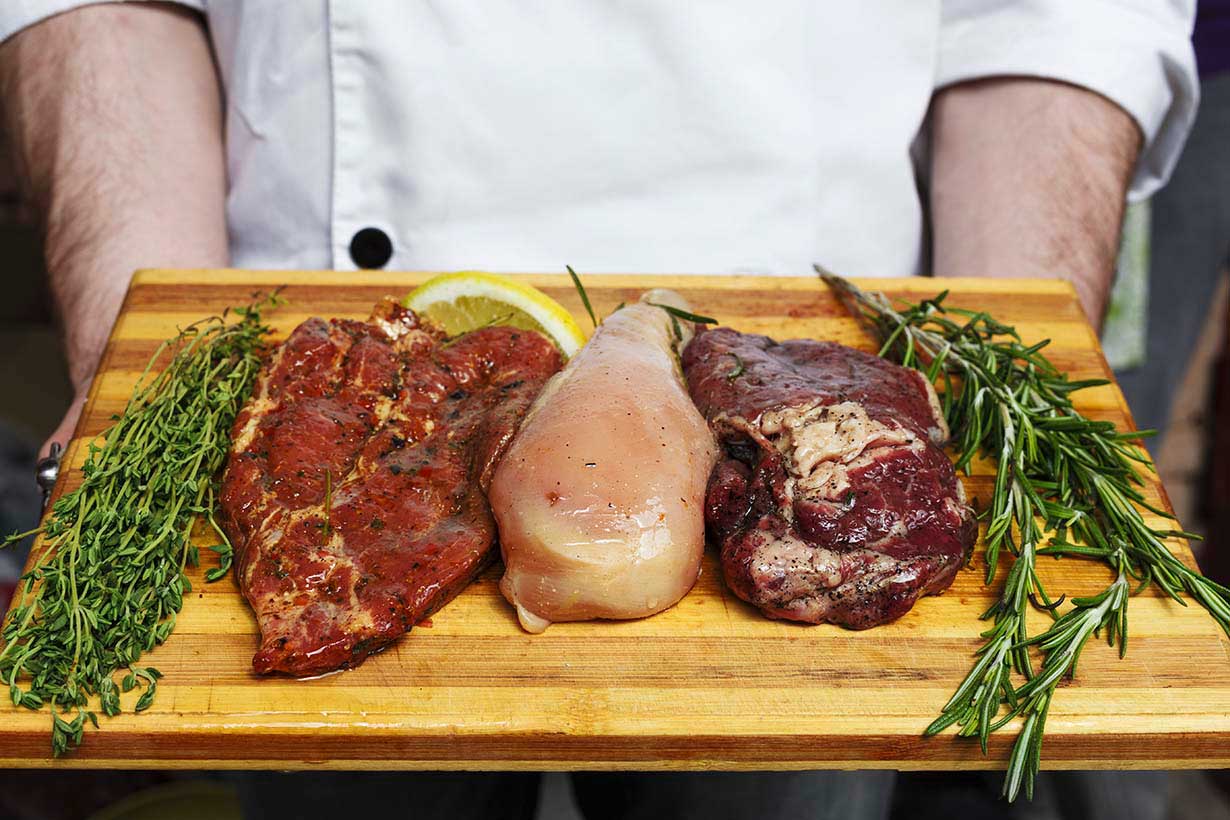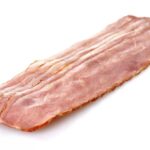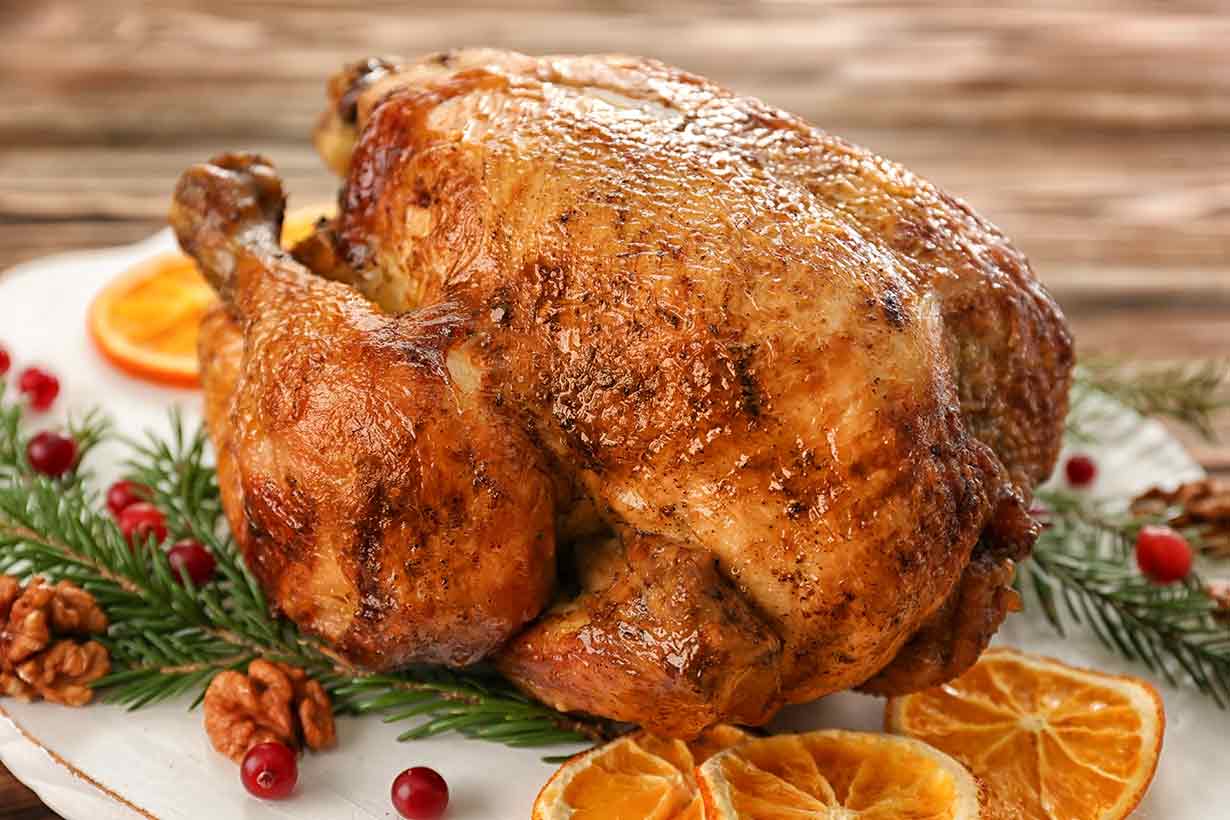Sausages are a popular food in countries worldwide, and they come in various varieties.
This comprehensive guide examines the world of sausages, the different varieties, and their nutritional values.
They’re all here from sausages based on different meat products, cured and smoked sausages, and even vegan sausages.
Table of contents
Types of Sausages

The word sausage dates back centuries, originally coming from the Latin word for salted: ‘salsus’ (1).
Yet interestingly, the earliest recorded history of sausages came 4,000 years ago in Mesopotamia, concerning a dish made with meat and intestine casings (2).
Since that time, sausages have become a popular food around the world. Furthermore, most countries and even regions have their own varieties.
In this guide, we will look at some different types of famous sausages from around the world.
For each sausage variety, you can see information on its origin, type, nutritional values, and general characteristics. Since the relative size of each sausage differs, nutritional values are ‘per 100 grams’ to allow for a fair comparison.
Unless otherwise stated, the data source for nutritional values is the USDA’s FoodData Central database.
Percent daily values (% DV) have been calculated using the FDA’s published daily values.
1) Beef Sausage
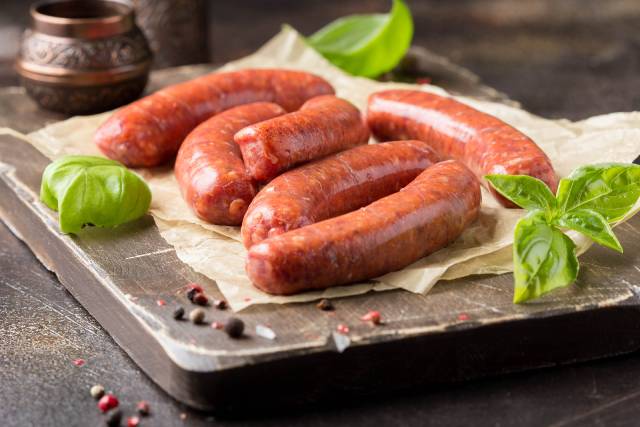
- Origin: multiple countries
- Type: fresh
- Main ingredients: beef, salt, herbs, and spices
Fresh beef sausages are popular worldwide, particularly in Germany, Poland, the United Kingdom, and the United States.
These sausages contain a mixture of ground beef, salt, and various herbs and spices.
Here are the typical nutritional values for cooked beef sausages per 100 grams (3):
- Calories: 332 kcal
- Carbohydrates: 0.35 g (<1% DV)
- Fiber: 0 g (0% DV)
- Sugars: 0 g
- Fat: 28.0 g (36% DV)
- Saturated: 10.9 g (55% DV)
- Monounsaturated: 12.6 g
- Polyunsaturated: 0.66 g
- Protein: 18.2 g (36% DV)
- Cholesterol: 82 mg (27% DV)
- Sodium: 813 mg (35% DV)
2) Berliner

- Origin: Germany
- Type: cooked sausage
- Main ingredients: beef, pork, salt, spices
The Berliner is a cooked and smoked sausage containing pork or beef.
Some Berliner products may also include liver, and the sausage typically has a high salt content.
Per 100 grams, the typical nutritional profile for Berliner sausage is as follows (4):
- Calories: 230 kcal
- Carbohydrates: 2.59 g (1% DV)
- Fiber: 0 g (0% DV)
- Sugars: 2.35 g
- Fat: 17.2 g (22% DV)
- Saturated: 6.08 g (30% DV)
- Monounsaturated: 8.0 g
- Polyunsaturated: 1.58 g
- Protein: 15.3 g (31% DV)
- Cholesterol: 46.0 mg (15% DV)
- Sodium: 1300 mg (57% DV)
3) Beyond Sausage

- Origin: United States
- Type: fresh, vegan alternative
- Main ingredients: water, pea protein, coconut oil, sunflower oil, flavorings, salt
Beyond Sausage is a plant-based vegan alternative to traditional sausages launched in June 2023 (5).
It tries to recreate the taste and texture of a traditional meat sausage using a combination of pea protein, oils, and various flavorings.
Nutritionally, Beyond Sausage is high in protein and has a similar fat content to reduced-fat pork and beef sausages.
Here are the nutritional values per 100 grams (6):
- Calories: 360 kcal
- Carbohydrates: 12.0 g (4% DV)
- Fiber: 2.0 g (7% DV)
- Sugars: 1.0g
- Fat: 22.0 g (28% DV)
- Saturated: 9.0 g (45% DV)
- Monounsaturated: 8.0 g
- Polyunsaturated: 4.0 g
- Protein: 32.0 g (64% DV)
- Cholesterol: 0 g (0% DV)
- Sodium: 1200 mg (52% DV)
For a complete nutritional breakdown of Beyond Sausage and how it compares to traditional sausages, see the following article:
Is Beyond Sausage a Healthy Choice? A Nutritional Guide
4) Blood Sausage

- Origin: multiple countries
- Type: cooked
- Main ingredients: blood, animal fat, grain (typically barley, oats, or rice), pork, salt, herbs, and spices
There are many different varieties of blood sausage around the world, including ‘black pudding’ in the United Kingdom, boudin noir (France), blodkorv (Sweden), and sundae (Korea).
Most blood sausage is pre-cooked, but people typically recook it before consumption.
A typical blood sausage product has the following nutritional profile (7):
- Calories: 379 kcal
- Carbohydrates: 1.29 g (<1% DV)
- Fiber: 0 g (0% DV)
- Sugars: 1.29 g
- Fat: 34.5 g (44% DV)
- Saturated: 13.4 g (67% DV)
- Monounsaturated: 15.9 g
- Polyunsaturated: 3.46 g
- Protein: 14.6 g (29% DV)
- Cholesterol: 120 mg (40% DV)
- Sodium: 680 mg (30% DV)
5) Boerewors
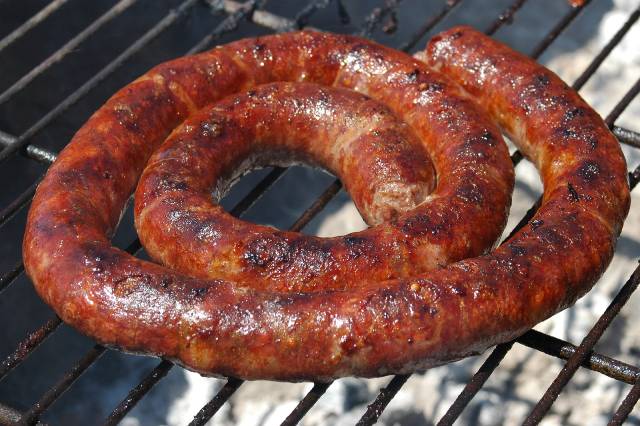
- Origin: South Africa
- Type: fresh
- Main ingredients: beef, sometimes pork or lamb, allspice, black pepper, cloves, coriander, nutmeg, salt, vinegar
Boerewors is a fresh type of sausage from South Africa primarily made with beef.
Sometimes it can include pork or lamb, and the sausages contain a mixture of herbs and spices in addition to salt and vinegar. Vinegar gives boerewors a unique flavor characteristic compared to other sausages.
Based on data from the NCC Food and Nutrient Database, here are the nutritional values for 100 grams of cooked boerewors (8):
- Calories: 233 kcal
- Carbohydrates: 1.02 g (<1% DV)
- Fiber: 0 g (0% DV)
- Sugars: 1.02 g
- Fat: 18.68 g (24% DV)
- Saturated: 8.02 g (40% DV)
- Monounsaturated: –
- Polyunsaturated: –
- Protein: 16.41 g (33% DV)
- Cholesterol: –
- Sodium: 704.19 mg (31% DV)
6) Bockwurst

- Origin: Germany
- Type: fresh
- Main ingredients: veal, pork, salt, paprika, white pepper
Bockwurst is another fresh German sausage that typically contains a combination of veal and pork.
It can also be smoked and may contain various herbs and spices.
The USDA database only has data for raw, uncooked bockwurst, shown below per 100 grams (9).
- Calories: 301 kcal
- Carbohydrates: 2.95 g (1% DV)
- Fiber: 1.0 g (4% DV)
- Sugars: 1.33 g
- Fat: 25.9 g (33% DV)
- Saturated: 10.3 g (52% DV)
- Monounsaturated: 13.1 g
- Polyunsaturated: 2.33 g
- Protein: 14.0 g (28% DV)
- Cholesterol: 93 mg (31% DV)
- Sodium: 756 mg (33% DV)
7) Chorizo

- Origin: Spain, Portugal
- Type: typically dry
- Main ingredients: pork, fat, smoked paprika, salt, possibly sodium nitrite and nitrate
Chorizo is a popular dry, fermented, and cured sausage from Spain that can be eaten uncooked.
However, with hundreds of chorizo varieties, this isn’t always the case. Some may be smoked and cooked, while others may be fresh and require cooking.
This makes it essential to carefully check the label of any chorizo products concerning any preparation requirements.
The intense red color of chorizo comes from its smoked paprika content, and the sausage has a chewy texture and slightly spicy taste.
Here are the typical nutritional values of chorizo per 100 grams (10):
- Calories: 341 kcal
- Carbohydrates: 2.63 g (1% DV)
- Fiber: 0 g (0% DV)
- Sugars: 0 g
- Fat: 28.1 g (36% DV)
- Saturated: 9.45 g (47% DV)
- Monounsaturated: 11.7 g
- Polyunsaturated: 4.74 g
- Protein: 19.3 g (39% DV)
- Cholesterol: 107 mg (36% DV)
- Sodium: 983 mg (43% DV)
8) Frankfurter

- Origin: Germany
- Type: cooked smoked
- Main ingredients: pork, chicken, beef, fat, salt, herbs and spices, sodium nitrate and/or nitrite
Originating in the city of Frankfurt, Germany, frankfurters are perhaps more famously known as ‘hot dogs.’
In this regard, they are one of two (alongside Vienna) sausages called hot dogs.
Pork is often the primary ingredient in frankfurters, but they may also contain chicken, beef, or even a mixture of the three. Frankfurters typically contain sodium nitrate and/or sodium nitrite as preservatives.
Per 100 grams, frankfurters typically provide the following nutritional values (11):
- Calories: 290 kcal
- Carbohydrates: 4.17 g (2% DV)
- Fiber: 0 g (0% DV)
- Sugars: –
- Fat: 25.8 g (33% DV)
- Saturated: 7.67 g (38% DV)
- Monounsaturated: 11.4 g
- Polyunsaturated: 4.4 g
- Protein: 10.3 g (21% DV)
- Cholesterol: 77 mg (26% DV)
- Sodium: 1090 mg (47% DV)
9) Kielbasa (kielbasa Polska)
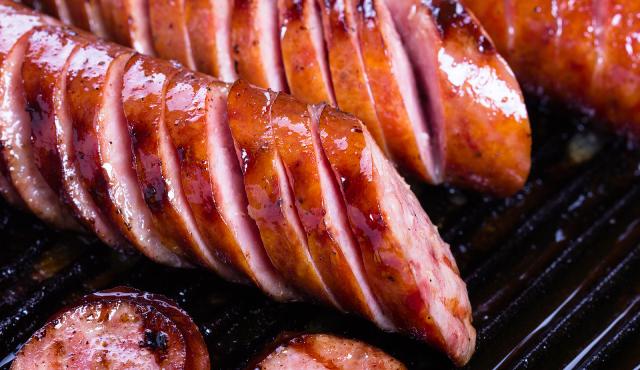
- Origin: Poland
- Type: cooked smoked
- Main ingredients: pork, beef, salt, garlic, various herbs and spices
Kielbasa means ‘sausage’ in Polish, and many different types of kielbasa (or sausage) exist in Poland. Some varieties may be fresh, and others could be pre-cooked or smoked.
However, ‘kielbasa’ typically refers to a smoked and pre-cooked sausage known as ‘kielbasa Polska.’
Since this sausage has been pre-cooked, it must only be reheated before consumption.
Presuming it is kielbasa Polska (the pre-cooked variety), kielbasa can also be eaten without cooking, but check the packaging label carefully to confirm.
100 grams of cooked kielbasa provides the following nutritional profile (12):
- Calories: 337 kcal
- Carbohydrates: 5.03 g (2% DV)
- Fiber: 0 g (0% DV)
- Sugars: 2.39 g
- Fat: 29.7 g (38% DV)
- Saturated: 9.89 g (49% DV)
- Monounsaturated: 12.6 g
- Polyunsaturated: 5.38 g
- Protein: 12.4 g (25% DV)
- Cholesterol: 73 mg (24% DV)
- Sodium: 1060 mg (46% DV)
10) Liverwurst
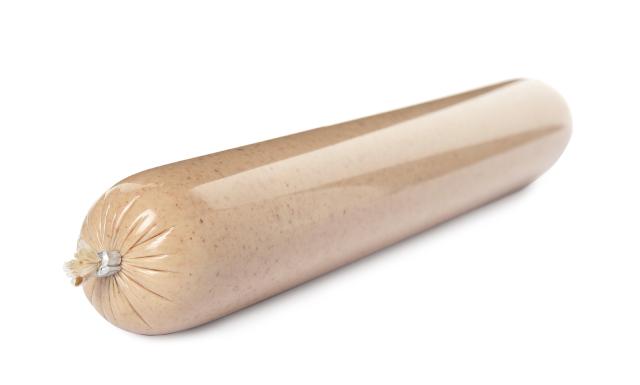
- Origin: Germany
- Type: cooked
- Main ingredients: liver, meat, fat, herbs and spices
Liverwurst is a German sausage containing liver, usually mixed with meat, fat, herbs, and spices.
As a pre-cooked sausage, it is ready to eat and available to buy in ‘firm’ and ‘spreadable’ varieties.
Liverwurst is high in fat and calories but contains a wide range of micronutrients; see this nutritional guide to liverwurst for more information.
Here are the nutritional values per 100 grams of spreadable liverwurst (13):
- Calories: 305 kcal
- Carbohydrates: 5.89 g (2% DV)
- Fiber: 2.5 g (9% DV)
- Sugars: 1.65 g
- Fat: 25.4 g (33% DV)
- Saturated: 9.92 g (50% DV)
- Monounsaturated: 12.3 g
- Polyunsaturated: 2.43 g
- Protein: 12.4 g (25% DV)
- Cholesterol: 118 mg (39% DV)
- Sodium: 700 mg (30% DV)
11) Luncheon sausage

- Origin: United States
- Type: cooked
- Main ingredients: pork, beef, fat, flour, sugar, herbs and spices, sodium nitrate and/or sodium nitrite
Luncheon sausage is a sausage-shaped variety of luncheon meat originating in the United States.
It can either be bought as a large sausage or, more commonly, sold in ready-sliced form.
Luncheon sausage has been pre-cooked and is ready to eat at the point of sale.
Each 100 grams of luncheon sausage typically offers the following nutritional values (14):
- Calories: 260 kcal
- Carbohydrates: 1.58 g (<1% DV)
- Fiber: 0 g (0% DV)
- Sugars: –
- Fat: 20.9 g (27% DV)
- Saturated: 7.62 g (38% DV)
- Monounsaturated: 9.93 g
- Polyunsaturated: 2.05 g
- Protein: 15.4 g (31% DV)
- Cholesterol: 64 mg (21% DV)
- Sodium: 1180 mg (51% DV)
12) Longaniza
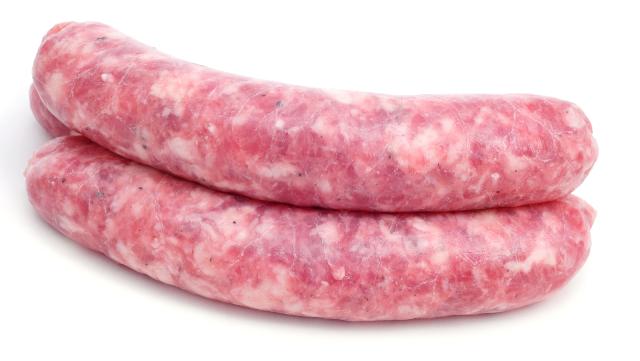
- Origin: Spain
- Type: fresh
- Main ingredients: pork, salt, pepper, garlic, nutmeg, sometimes vinegar and paprika
Longaniza is a traditional fresh Spanish sausage that must be cooked before eating. While the traditional Spanish recipe includes black pepper as a primary seasoning, there are different varieties in other countries.
For instance, longaniza is also popular in Spanish-speaking countries like Argentina, Chile, Mexico, Peru, and Uruguay. Each of these countries has its own way of seasoning longaniza, some being spicy and others milder.
Using data from the NCC Food and Nutrient Database, here are the nutritional values for cooked longaniza per 100 grams (8):
- Calories: 271 kcal
- Carbohydrates: 2.86 g (1% DV)
- Fiber: 1.43 g (5% DV)
- Sugars: 0 g
- Fat: 24.29 g (31% DV)
- Saturated: 8.57 g (43% DV)
- Monounsaturated: –
- Polyunsaturated: –
- Protein: 12.86 g (26% DV)
- Cholesterol: 64.29 mg (21% DV)
- Sodium: 857 mg (37% DV)
13) Pepperoni
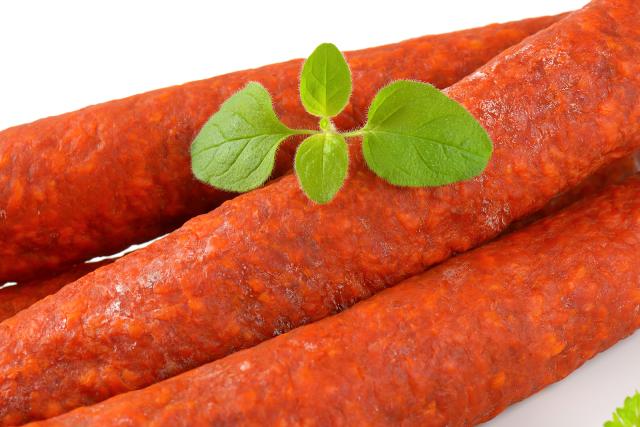
- Origin: United States
- Type: dry
- Main ingredients: pork, beef, fat, salt, paprika, spices, sodium nitrate and/or sodium nitrite
Despite common presumptions of Italian origin, pepperoni first appeared in Italian-American markets in the United States in the early 20th century (15).
Pepperoni is a cured, dried sausage and has not been cooked. It is ready to eat at the point of sale.
Among its many culinary uses, pepperoni is among the most popular pizza toppings.
Nutritionally, every 100 grams of pepperoni has the following values (16):
- Calories: 504 kcal
- Carbohydrates: 1.18 g (<1% DV)
- Fiber: 0 g (0% DV)
- Sugars: 0 g
- Fat: 46.3 g (59% DV)
- Saturated: 17.7 g (89% DV)
- Monounsaturated: 20.8 g
- Polyunsaturated: 4.46 g
- Protein: 19.2 g (38% DV)
- Cholesterol: 97 mg (32% DV)
- Sodium: 1580 mg (69% DV)
14) Pork sausage

- Origin: multiple countries
- Type: fresh
- Main ingredients: pork, herbs, spices, sometimes flour, salt
A typical fresh pork sausage may also be known by names such as ‘banger’ and ‘breakfast sausage.’
These sausages contain a primary ingredient of fresh, raw pork alongside varying herbs and spices, and salt. Depending on the sausage brand, they may also have a small amount of flour as a thickener and binder.
A typical cooked pork sausage has the following nutritional values per 100 grams (17):
- Calories: 325 kcal
- Carbohydrates: 1.42 g (<1% DV)
- Fiber: 0 g (0% DV)
- Sugars: 1.09 g
- Fat: 27.2 g (35% DV)
- Saturated: 8.83 g (44% DV)
- Monounsaturated: 11.5 g
- Polyunsaturated: 5.12 g
- Protein: 18.5 g (37% DV)
- Cholesterol: 86 mg (29% DV)
- Sodium: 814 mg (35% DV)
15) Salami
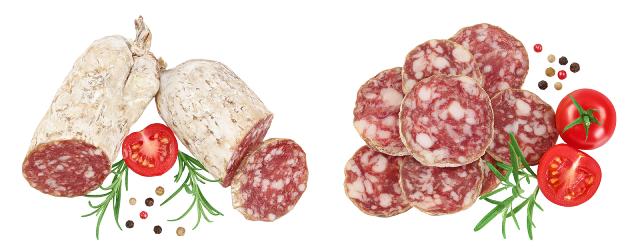
- Origin: Italy
- Type: dry
- Main ingredients: pork, beef, salt, pepper, herbs and spices, sodium nitrate and/or sodium nitrite
Originating in Italy, salami is a fermented, cured dry sausage usually made from pork. However, some salami products may use beef or a combination of the two.
Salami can take weeks to several months to produce, depending on the product.
As with other dried sausages, salami contains much higher fat and calories (and overall nutrients) than fresh sausages. Per 100 grams, pork salami has the following nutritional values (18):
- Calories: 425 kcals
- Carbohydrates: 1.2 g (<1% DV)
- Fiber: 0 g (0% DV)
- Sugars: 1.2 g
- Fat: 37 g (47% DV)
- Saturated: 13.1 g (66% DV)
- Monounsaturated: 18.2 g
- Polyunsaturated: 3.6 g
- Protein: 21.7 g (43% DV)
- Cholesterol: 80 mg (27% DV)
- Sodium: 1890 mg (82% DV)
16) Turkey sausage

- Origin: multiple countries
- Type: fresh
- Main ingredients: turkey, salt, spices, sometimes flour
Fresh turkey sausages, a form of ‘breakfast sausage’ or ‘banger,’ are similar to fresh pork and beef sausages in appearance.
However, they have a milder taste and a lower fat (and calorie) content. Nutritionally, they are also a richer source of protein.
Due to this nutritional profile, some people see turkey sausages as a type of “healthier” sausage compared to more traditional pork and beef sausages.
Cooked turkey sausages provide the following typical nutritional profile per 100 grams (19):
- Calories: 196 kcal
- Carbohydrates: 0 g (0% DV)
- Fiber: 0 g (0% DV)
- Sugars: 0 g
- Fat: 10.4 g (13% DV)
- Saturated: 2.27 g (11% DV)
- Monounsaturated: 2.99 g
- Polyunsaturated: 2.71 g
- Protein: 23.9 g (48% DV)
- Cholesterol: 92 mg (31% DV)
- Sodium: 665 mg (29% DV)
Find out more: Are Turkey Sausages a Healthy Choice?
17) Vienna sausage

- Origin: Austria
- Type: cooked smoked
- Main ingredients: pork, beef, chicken, herbs and spices, salt, sodium nitrate and/or sodium nitrite
Alongside Frankfurters, the Vienna sausage is another sausage used as a ‘hot dog.’
Pork is often the primary ingredient, but other meats such as beef, chicken, turkey, or a combination may also be used.
After grinding the meat into a paste, it is combined with salt, herbs, and spices before entering the sausage casing (20).
As Vienna sausages are pre-cooked, they can be consumed straight from the packet. However, most people recook them before eating.
Vienna sausages provide the following nutritional profile per 100 grams (21):
- Calories: 230 kcal
- Carbohydrates: 2.6 g (1% DV)
- Fiber: 0 g (0% DV)
- Sugars: 0 g
- Fat: 19.4 g (25% DV)
- Saturated: 7.12 g (36% DV)
- Monounsaturated: 9.63 g
- Polyunsaturated: 1.29 g
- Protein: 10.5 g (21% DV)
- Cholesterol: 87 mg (29% DV)
- Sodium: 879 mg (38% DV)
18) Weisswurst
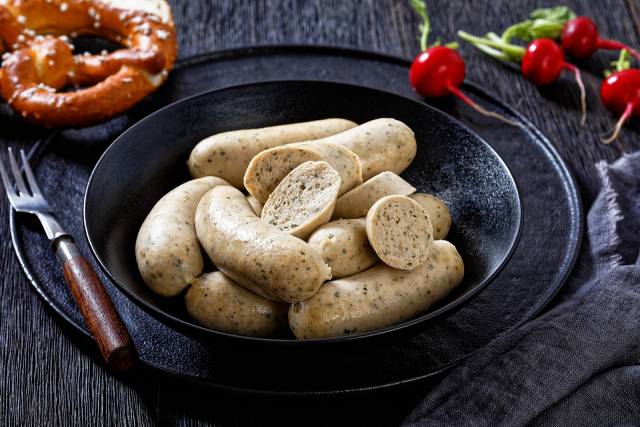
- Origin: Germany
- Type: fresh
- Main ingredients: veal, back bacon, salt, parsley, lemon zest, and other herbs and spices
‘Weisswurst’ is a fresh German sausage that translates to English as ‘white sausage.’
Veal tends to have a lighter color than pork or beef, so the sausage has a white appearance.
Additionally, weisswurst does not contain sodium nitrate or sodium nitrite, which adds a pink tinge to food when cooked. Therefore, this white sausage keeps its pale characteristics during and after cooking.
A typical weisswurst sausage has the following nutritional profile per 100 grams (22):
- Calories: 283 kcal
- Carbohydrates: 1.77 g (<1% DV)
- Fiber: 0 g (0% DV)
- Sugars: 0 g
- Fat: 26.6 g (34% DV)
- Saturated: 8.85 g (44% DV)
- Monounsaturated: –
- Polyunsaturated: –
- Protein: 10.6 g (21% DV)
- Cholesterol: 53 mg (18% DV)
- Sodium: 646 mg (28% DV)
Reduced Fat Sausage Varieties
In addition to regular beef and pork sausages, it is also possible to buy common reduced-fat varieties.
These low-fat options have a lower fat and overall calorie provision and correspondingly higher protein content. For this reason, they may be a good choice for people wishing to limit their overall calorie or saturated fat intake.
They could also be a good choice for increasing dietary protein intake.
Beef and pork sausages, reduced fat
Reduced-fat beef and pork sausages with a fat content of 20% typically provide the following nutritional values per 100 grams (23, 24):
- Calories: 267 kcal
- Carbohydrates: 0.15 g (<1% DV)
- Fiber: 0 g (0% DV)
- Sugars: 0 g
- Fat: 20.3 g (26% DV)
- Saturated: 6.03 g (30% DV)
- Monounsaturated: 8.02 g
- Polyunsaturated: 4.19 g
- Protein: 20.9 g (42% DV)
- Cholesterol: 82 mg (27% DV)
- Sodium: 698 mg (30% DV)
Final Thoughts
This article shows that ‘sausage’ can mean quite different things.
There are numerous types of sausages, from fatty fresh sausages to low-fat varieties, cured options, and even vegan-friendly choices.
However, it is worth noting that most sausages are high in saturated fat, sodium, and preservatives like sodium nitrate.
For those who enjoy sausages, it is better to use them as an occasional food rather than a staple in the daily diet.



